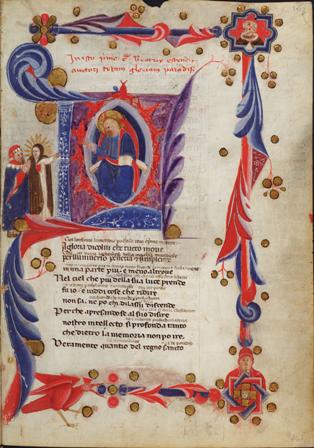
The beginning of Paradiso. Gg.3.6
Anyone who wishes for a detailed insight into acquisition policies is advised to consult the Library's extremely detailed Collection development policy. What follows is a summary of that document, in as far as it pertains to Italian materials.
Italian History
Italian history is covered in considerable depth. Subject areas of particular importance include medieval Italy, the Renaissance and Italian humanism, the Risorgimento, the First World War, Mussolini, Italian colonisation in Africa, and the political and economic history of contemporary Italy.
A particular strength of the Italian language collection is classical archaeology, not only of the peninsula but also of the Hellenistic and Roman Mediterranean world.
The religious history of Italy is a central theme of the collection, with extensive historical and biographical holdings on the papacy, on local church history down to the level of the diocese, city, or monastery, the Waldensians, the Roman Inquisition, the Counter Reformation, and Church-State relations since Italian Unification. Particular efforts are made to acquire source materials such as cartularies, lives of saints, correspondence and registers, as well as guides to and catalogues of archives. The Acton Collection is especially rich in materials relating to Italian Church history.
Local history as such is also a major focus, and this is reflected in the classification scheme. The collection is especially strong in the areas of medieval cities and communes, and of Italian Jewish communities.
Literature and Culture
Perhaps the largest section of the Italian collection covers literature. Literary texts, critical studies, and works of reference covering all periods of Italian literature are systematically collected. There is a comprehensive collection of the writings of all major Italian authors from Dante and Petrarch onwards, with a special emphasis on securing important critical editions.
Coverage also includes many Italian dialects, with the acquisition of literary texts as well as of linguistic studies and of dialect dictionaries, glossaries, and grammars. The history of the Italian language is also very well represented.
A growing element of the collection in recent years has been cinema and film studies.
Fine Arts
The fine arts are central to Italian culture, and this is fully reflected in the collection. A very large number of critical studies, exhibition and collection catalogues, and biographies are acquired, many of them with illustrations of the highest quality (most illustrated works on the fine arts will be held in closed access classes, chiefly S-three figures). Painting, sculpture and architecture of the Medieval, Renaissance, Baroque, Romantic and Modern eras are all covered in depth.
